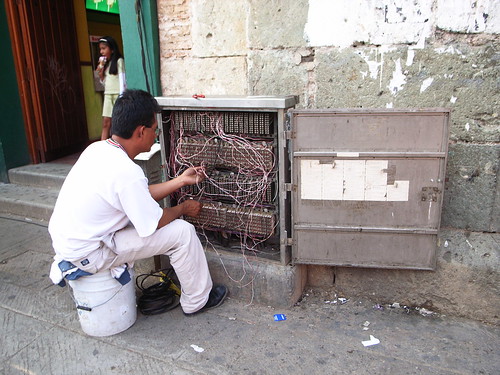Leigh Star, S. (1999). the ethnography of infrastructure, American Behavioral Scientist, 43(3), pp.377-391. This article interestingly propose to take an ethnographical approach of infrastructures, and study these so-called "boring things" as indicators of practices and culture. Phone books, international classification of disease or power plugs are described as important indicators by the author. The point is not only to "study the unstudied" for the sake of it bur rather to take them as a relational concept ("for a railroad engineer, the rails are not infrastructure but topic").
She then defines infrastructures with 9 properties:
"Embeddedness. Infrastructure is sunk into and inside of other structures, social arrangements, and technologies. (...) Transparency. Infrastructure is transparent to use, in the sense that it does not have to be reinvented each time or assembled for each task, but invisibly supports those tasks. (...) Reach or scope. This may be either spatial or temporal—infrastructure has reach beyond a single event or one-site practice. (...) Learned as part of membership. The taken-for-grantedness of artifacts and organizational arrangements is a sine qua non of membership in a community of practice (...) Links with conventions of practice. Infrastructure both shapes and is shaped by the conventions of a community of practice (...) Embodiment of standards. Modified by scope and often by conflicting conventions, infrastructure takes on transparency by plugging into other infrastructures and tools in a standardized fashion. (...) Built on an installed base. Infrastructure does not grow de novo; it wrestles with the inertia of the installed base and inherits strengths and limitations from that base (...) Becomes visible upon breakdown. The normally invisible quality of working infrastructure becomes visible when it breaks (...) Is fixed in modular increments, not all at once or globally. Because infrastructure is big, layered, and complex, and because it means different things locally, it is never changed from above."
Why do I blog this? "Reading" infrastructures can be done by identifying the "master narratives" and "others" (i.e. the single voice who does not problematize diversity), find the invisible work (i.e. the traces left behind by coders, engineers, builders) and understand why people "persist in using less functional but more routine actions when cheaper alternatives are nearby". This obviously utterly echoes with the near future laboratory concerns and methodologies.
 What would this infrastructure - currently being fixed - reveal from the society? (Picture taken in Oaxaca, Mexico, last week)
What would this infrastructure - currently being fixed - reveal from the society? (Picture taken in Oaxaca, Mexico, last week)